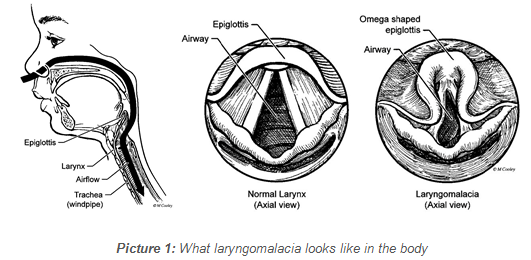Laryngomalacia (Laryngeal Stridor)
![]()
Laryngomalacia (LAYR inn go mah LAY shah) is also called laryngeal stridor. It results from a weakness of parts of the voice box (larynx) that is present at birth. This condition can cause a high-pitched sound called stridor (STRI der). You may hear this sound when your child breathes in.
Cause of Laryngomalacia
Laryngomalacia means “soft larynx.” It is caused by floppiness of the tissue above the vocal cords (called the supraglottic larynx). When a person breathes in (inspiration), these tissues fall in towards the airway and cause the airway to be partly blocked. This blockage at the area of the voice box creates noisy breathing (called stridor).

Laryngomalacia is the most common cause of noisy breathing in infants. More than half of infants have noisy breathing during the first week of life. Most other babies have it within 2 to 4 weeks of birth. It is rare, but laryngomalacia can happen in older children or adults, usually those with other medical problems.
Signs and Symptoms
The main symptom of laryngomalacia is noisy breathing when your child breathes in. This is called inspiratory stridor. Stridor may:
-
Change with activity. It may be louder when your child is upset, crying, or is excited.
-
Be louder when your child has a cold.
-
Usually it will be louder when your child is lying on his or her back, and quieter when he is lying on his stomach.
In more severe cases of laryngomalacia, there may be:
-
Vomiting or spitting up food (reflux)
-
Poor weight gain
-
Difficulty eating
-
Choking on food
-
Pauses in the breathing (apnea) or turning blue (cyanosis)
-
Chest or neck sinking in when breathing (retractions)
Diagnosis
Your child’s doctor may think your baby has laryngomalacia after a physical exam. Some tests may be done in the doctor’s office on a child who is awake. Laryngoscopy (lay rinn GOSS koh pee) and Nasopharyngoscopy (nay zoh fayr inn GOSS koh pee) are tests that let the doctor see exactly how the voice box is working. If these tests in the office do not explain your child’s symptoms, his or her doctor may order extra tests.
Treatment
In most cases, this is a harmless condition that goes away on its own without treatment. It usually improves by the time the child reaches 18 months of age. There are no long-term complications, but a small number of children may develop severe breathing problems that may require surgery or other medical treatment. Sometimes children with laryngomalacia are also treated with medicine for reflux.
When to Call the Doctor
If you see any of the following things, call your child’s doctor.
-
Your child looks like he or she is working harder to breathe. You may notice he is breathing faster or slower than usual, taking shallow breaths, or flaring or retracting his nostrils.
-
Your child’s skin turns bluish around the lips.
-
Your child is not gaining weight.
If you have questions or concerns, be sure to ask your child’s doctor or nurse.
HH-I-332 Revised 3/15 Copyright 2011, Nationwide Children’s Hospital



